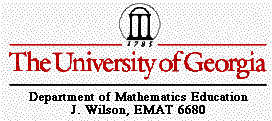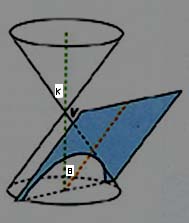

In the 3rd century B.C., only about 25 years after the appearance of Euclid's Elements, another Greek mathematician, Appollonius, wrote a set of books entitled Conics, dealing with the curves formed by intersecting a cone with a plane; the result giving rise to ellipses, parabolas, and hyperbolas.
Appollonius did not consider any applications of these curves, but 1800 years later, in the 10-year period from 1609 to 1619, the German scholar Johannes Kepler performed one of the greatest examples of mathematical modeling of all time. Until Kepler, almost all people thought that the planets moved in circles (either around the earth or the sun) and the stars were fixed on a celestial sphere. Using the measurements of the positions of the planets obtained by his teacher, the Danish astronomer Tycho Brahe, Kepler found that the orbits of the planets around the sun were ellipses and that these ellipses satisfied several simple but not obvious properties.
At about the same time, descartes applied his new coordinates (the rectangular coordinates) to the geometry of the conic sections and found that all conics could be described by equations of the form Ax^2 + Bxy +Cy^2 +Dx + Ey + F = 0. Because the greatest degree of any term in this equation is 2, the sets of ordered pairs (x,y) satisfying it are called quadratic relations or quadratic expressions. These give rise to quadratic equations.
The 'cone' that gives rise to a conic section is not the same as the cones studied in geometry. In geometry, a right cone looks like the bottom half only of the figure below. However, the conic section cone is formed by rotating one of two intersecting lines about the other. The fixed line is called the axis of the cone; the vertical green line in the picture below is considered the axis (it's mostly hidden and can be seen in the top nappe). The point of intersection of these lines is the cone's vertex (where the two cones meet). Any position of the rotating line is an edge of the cone. The conic section cone has two parts (like ice cream cones on top of each other) called nappes, one on each side of its vertex, as shown in the picture below:

In general, a cross section or section of a three-dimensional figure is the intersection of a plane with that figure. The three figures below are the sections of a cone formed when a plane intersects the cone but does not contain the cone's vertex:

Parabola: note in the picture above that the plane is parallel to the edge of the nappe and cuts through only the upper nappe. It does not have to be the upper nappe only; the plane could intersect the lower nappe alone as well.

Ellipse: note that the plane is not parallel to any edge but still only cuts through one nappe (here, the upper nappe). Back to the lesson on Ellipses

Hyperbola: note that the plane cuts through both the upper and lower nappes.
When the plane is parallel to one edge of both nappes, as shown in the parabola (3 pictures prior), the section formed is a parabola. Note in the picture below, the 'smile' or parabola is able to be seen with the top of the upper nappe bent over and facing toward us:

Now we have to be a little more technical. Observe this picture of a parabola:

This is a see-through picture of a conic, parabola and a plane (in blue, not red) in the lower nappe. The vertical green line is the axis and V is the vertex. The letter k is the angle between the vertical green line and the left side edge of the upper nappe. It is also the angle between the green line and all edges in either the upper or lower nappes. The letter below, (that looks like a B or the number 8) in the lower nappe, is actually the greek letter theta (pronouned thay-ta). Theta is the angle between the vertical green line (the cone's axis) and the plane (denoted by the orange line). When k = theta then you have a parabola. When theta > k you have an ellipse; when theta < k you have a hyperbola. Go back to the pictures of the various conic sections and try to visualize the relationship between theta and k.
I have put more emphasis on the discussion about the parabola. This is due to the fact that the parabola is the topic at hand; the ellipse and the hyperbola will be dealt with in the next several lessons.
Don't forget to go back to Day 1 Lesson 1 and try the challenge.
** Note: We are indebted to the UCSMP (University of Chicago School Mathematics Project) series for information on Conics.
Return to Conic section main page